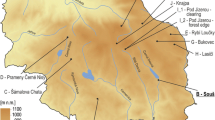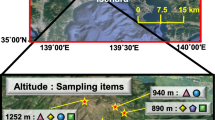Abstract
The results of field experiments on fog pollutant deposition enhanced by local mountain climate, completed by the dendrochronological analysis of the forest response, are presented in this paper. In spite of their low absolute altitude (1,000–1,600 m a.s.l), the Sudetes and the Silesian Beskid form a noticeable orographic barrier for the airflow of the humid Atlantic air masses. This results in the increase of cloudiness and fog frequency as well as both atmospheric precipitation and horizontal precipitation volume. Between January and December 2009 the daily samples of atmospheric precipitation and rime were collected on three selected mountain tops of similar height. The selected measurement sites were situated along a 300 km WNW-ESE profile parallel to the direction of the prevailing atmospheric circulation. High day-to-day variability of rime water volume, the total ionic content and chemical composition of the individual samples were typical of each measurement site and depended on the emission patterns, synoptic situation and the local climatic conditions influenced chiefly by terrain relief. Significantly larger rime efficiency and pollution deposition via fog were observed at the westernmost Szrenica Mt site rather than more to the southeast at Śnieżnik Mt and Skrzyczne Mt. This difference should be explained by more intense orographic deformation of predominant airflow from the western sector as well as the higher liquid water content of fog in the vicinity of Szrenica. Both temporal and spatial variability of fog deposition correlates closely with the health status of the drilled trees of Norway Spruce (Picea Abies) in the Śnieżnik Massif. The averaged annual tree rings width near the local tree line (1,350 m a.s.l.) on the summit dome of Śnieżnik decreased by 71% between 1950 and the early 1980s. This is also the area of the highest rate of atmospheric pollutant deposition due to particularly important role of fog. At an altitude of 1,200 m a.s.l. The relevant changes of ring width were different depending on slope aspect: 60% on western slopes well exposed for orographic fog formation and 42% on eastern slopes where fog deposition is less intense. The results of the dendrochronological analysis provide the evidence for the upward trend of tree rings width since 1981–1984 break through up to date, which should be attributed to the progressive reduction of pollutant emission in Central Europe.











Similar content being viewed by others
References
Agren, Ch. (1988), Critical loads. Figures continuing downwards, Acid News 3, 1–4.
Baranowski, S., and Liebersbach, J. (1978), The intensity of different kinds of rime on the upper tree line in the Sudety Mountains, J Glaciol. 19, 489–497.
Błaś, M., and Sobik. (2003) Natural and human impact on pollutant deposition in mountain ecosystems of the Sudetes, In Man and climate in the XX century (ed. Pyka, J.) (Acta Univ. Wratisl. 2542, Studia Geograficzne 75, Wrocław), pp. 420–438.
Błaś, M., and Sobik, M. (2000), Fog in the Giant Mountains and selected European massifs, Opera Corcontica 37, 35–46.
Błaś, M., and Sobik, M. (2004), The distribution of fog frequency in the Carpathians, Geographia Polonica—General and Applied Climatology: Selected Aspects 77, 19–34.
Błaś, M., Sobik, M., Quiel, F., and Netzel, P. (2002), Temporal and spatial variations of fog in the Western Sudety Mts., Poland, Atmos. Res. 64, 19–28.
Błaś, M., Sobik, M., and Twarowski, R. (2008) Changes of cloud water chemical compositions in the Western Sudety Mountains, Poland, Atmos. Res. 87, 224–231.
Błaś, M., Polkowska, Ż., Sobik, M., Klimaszewska, K., Nowiński, K., and Namieśnik, J. (2010), Fog water chemical composition in different geographic regions of Poland, Atmos. Res. 95, 455–469.
Chowaniec, J. (1991) Region karpacki, In Budowa Geologiczna Polski, vol. VII Hydrogeologia (Ed. Malinowki, J.) (Wydawnictwa Geologiczne, Warszawa), pp. 204–215.
Danek, M. (2007), The influence of industry on scots pine stands in the south-eastern part of the Silesia-Kraków Upland (Poland) on the basis of dendrochronological analysis, Water Air Soil Pollut. 185, 265–277.
Dore, A.J., Choularton T.W., Brown, R., and Blackall, R.M. (1992), Orographic rainfall enhancement in the mountains of the Lake District and Snowdonia, Atmos. Environ. 26A, 357–371.
Drukman, I., Migała, K., and Sobik, M. (1997) Selected Characteristics of wind speed structure in the West Karkonosze Mts., In Climatological Aspects of environment protection in mountain areas (ed. Migała, K.). Acta Univ. Wratisl., Prace Instytutu Geograficznego, s. C, Meteorologia i Klimatologia, IV, Wrocław) pp. 67–73.
Elbert, W., Hoffmann, M.R., Kramer, M., Schmitt, G., and Andreae, M.O. (2000), Control of solute concentrations in cloud and fog water by liquid water content, Atmos. Environ. 34, 1109–1122.
EMEP Data Report, Acidifying and eutrophying compounds and particulate matter (Norwegian Institute for Air Research 2010).
EMEP Status Report, Transboundary Acidification, Eutrophication and Ground Level Ozone in Europe in 2008 (Norwegian Meteorological Institute 2010).
Feliksik, E. (1995), Dendrochronological monitoring of the threat to the forest of Western Beskids created by industrial immisions, Zpravodaj Beskydy 7, 23–34.
Feliksik, E., and Wilczyński, S. (2003), Tree ring as indicators of environmental change, Electronic Journal of Polish Agricultural Universities, series Forestry 6/2.
Ferretti, M., Innes, J.L., Jalkanen, R., Saurer, M., Schäffer, J., Spiecker, H., and von Wilpert, K. (2002), Air pollution and environmental chemistry—what role for tree-ring studies? Dendrochronologia. 20, 159–174.
Fritts, H.C., Tree Rings and Climate (Academic Press, London 1976).
Godek, M., Migała, K., and Sobik M. (2009), Air pollution and forest disaster in the Western Sudetes in the light of high elevation spruce tree ring data, TRACE Tree Rings in Archeology, Climatology and Ecology, Procc. of the DENDROSYMPOSIUM 2008, Zakopane. 7, 121–126.
Huettl, R.F., and Mueller-Dombois, D. (1993) Forest decline in the Atlantic and Pacific Region (Springer Verlag, Berlin).
Igawa, M., Matsumura, K., and Okochi, H. (2001), Fog water chemistry at Mt. Oyama and its dominant factors, Water Air Soil Pollut. 130, 607–612.
Jała, Z., and Błaś, M. (2000), Choisen chemical characters of soils against a background of a wet deposition of air pollution in the Sudetes, Opera Corcontica 37, 69–78.
Jones, A., Choularton, T.W. (1988), A model of wet deposition to complex terrain, Atmos. Environ. 22 (11), 2419–2430.
Kim, D.S., and Aneja, V.P. (1992), Chemical composition of clouds at Mount Mitchell, North Carolina, Tellus 44B, 41–53.
Krąpiec, M., and Szychowska-Krąpiec E. (2001), Tree-ring estimation of the effect of industrial pollution on pine (Pinus sylvestris) and fir (Abies alba) in the Ojców National Park (Southern Poland), Nature Conservation 58: 33–42.
Kryza, H., Kryza, J., and Marszałek, H. (2005) Wody podziemne Karkonoszy, In Karkonosze, Przyroda Nieożywiona i Człowiek (ed. Mierzejewski M. P.)(Wrocław) pp. 453–486.
Kryza, M., Błaś, M., Dore, A.J., and Sobik, M. (2009) Application of a Lagrangian Model FRAME to estimate reduced nitrogen deposition and ammonia concentrations in Poland, In atmospheric ammonia: detecting emission changes and environmental impacts. Results of an expert workshop under the convention on long-range transboundary air pollution (ed. Sutton, M.A.) (Springer) pp. 357–366.
Kryza, M., Błaś, M., Dore, A.J., and Sobik, M. (2010), Fine-resolution modeling of concentration and deposition of nitrogen and sulphur compounds for Poland—application of the FRAME model, Arch. Environ. Prot. 36(1), 49–62.
Lovett, G.M. (1984), Rates and mechanism of cloud water deposition to a subalpine balsam fir forest, Atmos. Environ. 18, 361–371.
Malik, I., Danek, M., and Krąpiec, M. (2009) Air pollution recorded in scots pine growing near a chemical plant, preliminary results and perspective (Upper Silesia, southern Poland), In trace tree rings in archeology, climatology and ecology, vol.8, Procc. of the DENDROSYMPOSIUM 2009, Otočec, Slovenia, (ed. Levanic, T.) (GFZ Potsdam, Scientific Technical Report STR, Potsdam) pp. 41–45.
Matuszkiewicz, J.M. (2002) Zespoły leśne Polski (Wydawnictwo Naukowe PWN, Warszawa).
Migała, K., Liebersbach, J., and Sobik, M. (2002), Rime in the Giant Mts. (The Sudetes, Poland), Atmos. Res. 64, 63–73.
Mill, W. (2006), Temporal and spatial development of critical loads exceedance of acidity to Polish forest ecosystems in view of economic transformations and national environmental policy, Env. Sci. Pol. 9, 563–567.
Mill, W.A., Schlama, A., Twarowski, R., Błachuta, J., and Stasyewski, T. (2003) Modelling and mapping of critical thresholds in Europe. CCE Status Report 2003, National Focal Centre Report—Poland (Bilthoven, Netherlands).
Mitosek, G., Degórska, A., Iwanek, J., Przybylska, G., and Skotak, K. (2004) EMEP Assessment Report—Poland. (Institute of Environmental Protection, Warsaw).
Möller, D. (1984), Estimation of the global man-made sulphur emission, Atmos. Environ. 18, 19–27.
Moravčik, P., and Černý, M. (1995) Forest die-back affected regions of Czech Republic, In Acid Reign’95, acidification in the black triangle (ed. Grennfeld, P.) (Proceeding from the 5th International Conference on Acid Deposition, Göeteborg).
Niedźwiedź, T. (2010) Kalendarz typów cyrkulacji atmosfery dla Polski południowej—zbiór komputerowy [Calendar of atmospheric circulation types for the Southern Poland—Internet database], (Uniwersytet Śląski, Katedra Klimatologii, Sosnowiec).
Nilsson, J., and Grennfelt, P., Critical loads of Sulphur and Nitrogen (Nordic council of Ministers, Report, Copenhagen 1988) pp. 8–57.
Olejarski, I., Oszako, T., and Hilszczańska, D. (2004), Evaluation of health status of forest ecosystems in Sudetes after ecological disaster with special regard to revitalization of forest soils and its influence on regeneration, Opera Corcontica 41, 421–433.
Olendrzyński, K., Kargulewicz, I., Skośkiewicz, J., Dębski, B., Cieślińska, J., Olecka, A., Kanafa, M., Kania, K., and Sałek, P. (2009) Poland’s National Inventory Report 2009 (National Administration of the emission traiding Scheme, Institute of Environmental Protection, Warszawa,) pp. 189.
Pahl, S., Winkler, P., Schneider, T., Arends, B., and Schell, D. (1994), Deposition of trace substances via cloud interception on a coniferous forest at Kleiner Feldberg, J Atmos. Chem. 19, 231–252.
Pereyma, J., Sobik, M., Szczepankiewicz-Szmyrka, A., and Migała, K. (1997), Contemporary climatic conditions and topoclimatic differentiation of the Karkonosze Mts., Acta Univ. Wratisl., Prace Instytutu Geograficznego IV, 75–94.
Polkowska, Ż., Astel, A., Walna, B., Małek, S., Mędrzycka, K., Górecki T., Siepak, J., and Namieśnik J. (2005), Chemometric analysis of rainwater and throughfall at several sites in Poland, Atmos. Environ. 39, 837–855.
Schweingruber, F.H. (1996) Tree Rings and Environment Dendroecology (Swiss Federal Institute for Forest, Snow and Landscape Research, Birmensdorf).
Schweingruber, F.H. (2007) Wood Structure and Environment (Springer Series in Wood Science, Berlin).
Sobik, M. (1999) Meteorologiczne uwarunkowania zakwaszenia hydrometeorów w Karkonoszach (Unpublished Ph.D. Thesis, Wrocław, University of Wrocław).
Sobik, M., Dore, A.J., and Migała, K. (1998) Influence of orography on wet deposition patterns in the Western Sudetes, In Geoecological Problems of the Karkonosze Mountains, Transborder Biosphere Reserve Karkonosze/Krkonoše, pp. 97–108.
Strzyszcz, Z. (1995), Warunki glebowe a zamieranie drzewostanów w Karkonoskim Parku Narodowym, Geoekologiczne problemy Karkonoszy, Poznań, 89–94.
Vinš, B., and Pollanschütz, J. (1977), Erkennung and Beurteilung immissionsgeschädigter Wälder anhand von Jahrringanalysen. [Identification and assessment of damaged forests on the basis of tree-ring analysis], Alg. Forstzeit. 6, 146–148.
Wallen, C.C. (1977) World Survey of Climatology Volume 6—Climates of Central and Southern Europe (ed. Landsberg, H.E.) (World Meteorological Organisation, Geneva).
Weathers, K.C., Lovett, G.M., and Likens, G.E. (1995), Cloud deposition to a spruce forest edge, Atmos. Environ. 29, 665–672.
Wiśniowski, Z. (2001) Dendrochronologiczno-geochemiczna analiza przemysłowej degradacji środowiska na przykładzie lasów Puszczy Wkrzańskiej (aglomeracja szczecińska) (Państwowy Instytut Geologiczny, Warszawa).
Wrzesinsky, T., and Klemm, O. (2000), Summertime fog chemistry at a mountainous site in central Europe, Atmos. Environ. 34, 1487–1496.
Żelaźniewicz, A. (2005) Przeszłość geologiczna, In Przyroda Dolnego Śląska, (ed. Fabiszewski, J.) (PAN, Wrocław) pp. 61–134.
Zimmermann, L., Zimmermann, F. (2002), Fog deposition to Norway Spruce stands at high-elevation sites in the Eastern Erzgebirge (Germany), J Hydrol. 256, 166–175.
Acknowledgments
This scientific work was financially supported by the Polish Ministry of Science and Higher Education between 2008 and 2010 as a research project (N N305 231035).
Author information
Authors and Affiliations
Corresponding author
Rights and permissions
About this article
Cite this article
Godek, M., Błaś, M., Sobik, M. et al. Environmental Role of Rime Chemistry at Selected Mountain Sites in Poland. Pure Appl. Geophys. 169, 1093–1106 (2012). https://doi.org/10.1007/s00024-011-0360-9
Received:
Revised:
Accepted:
Published:
Issue Date:
DOI: https://doi.org/10.1007/s00024-011-0360-9




